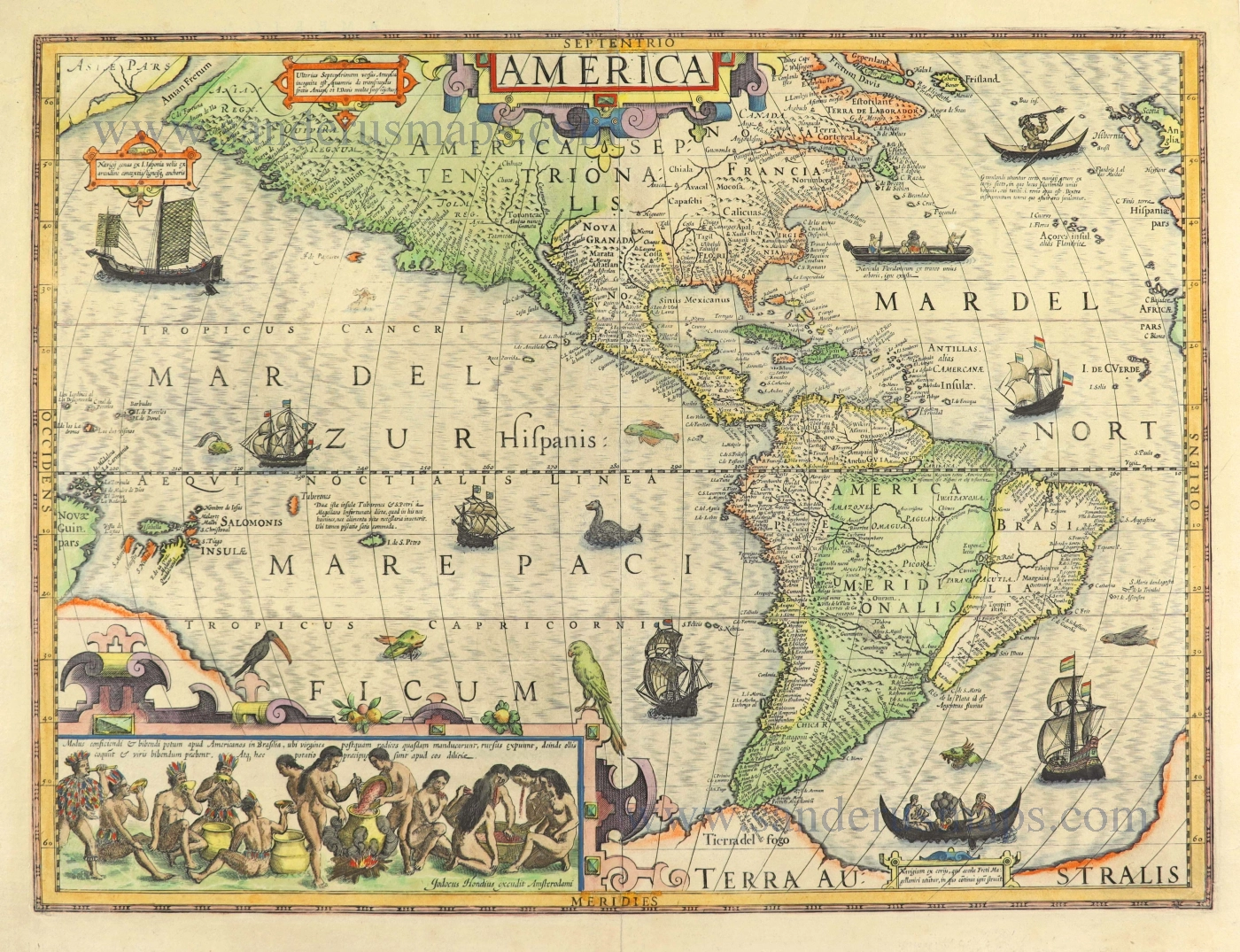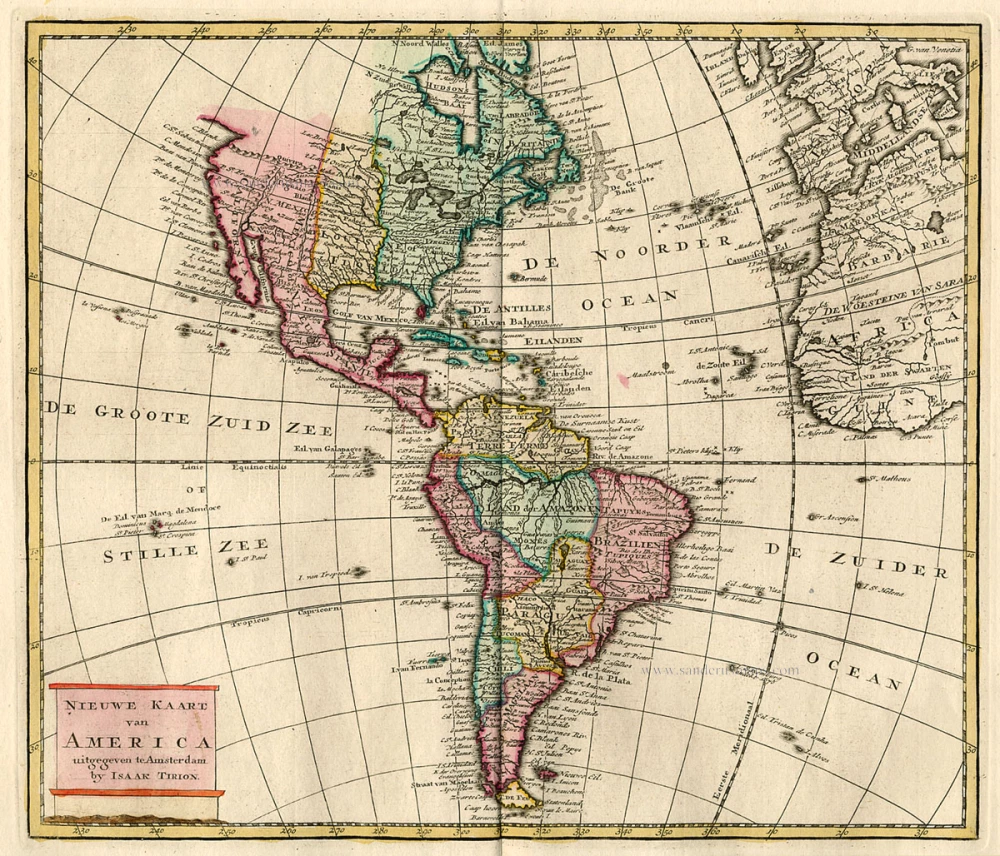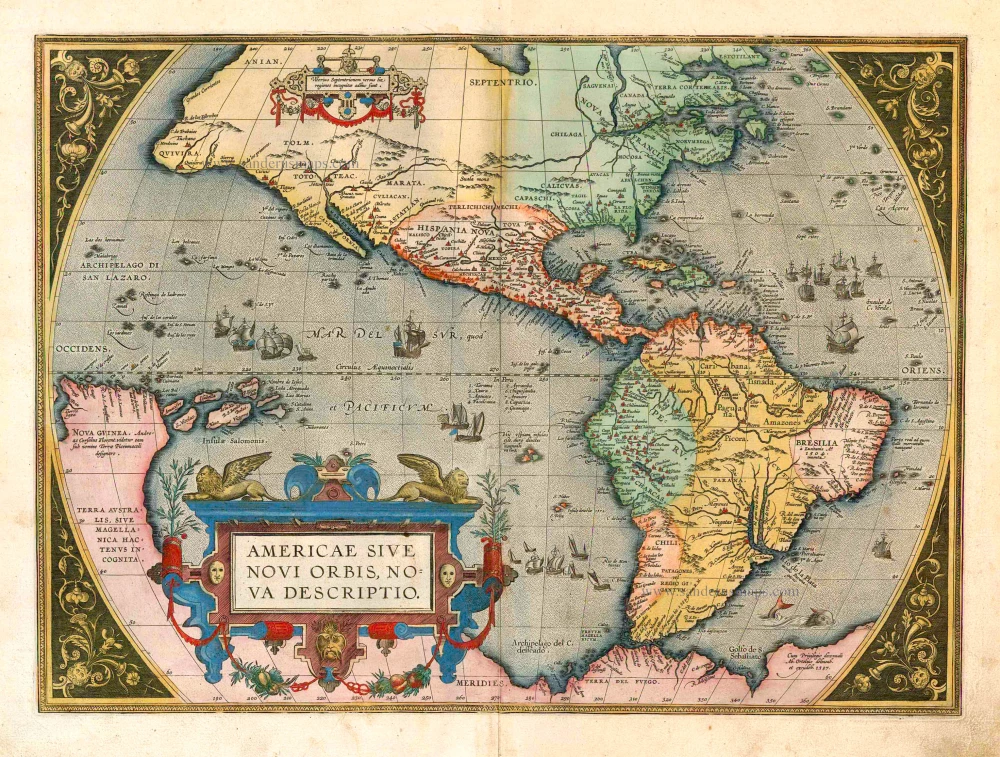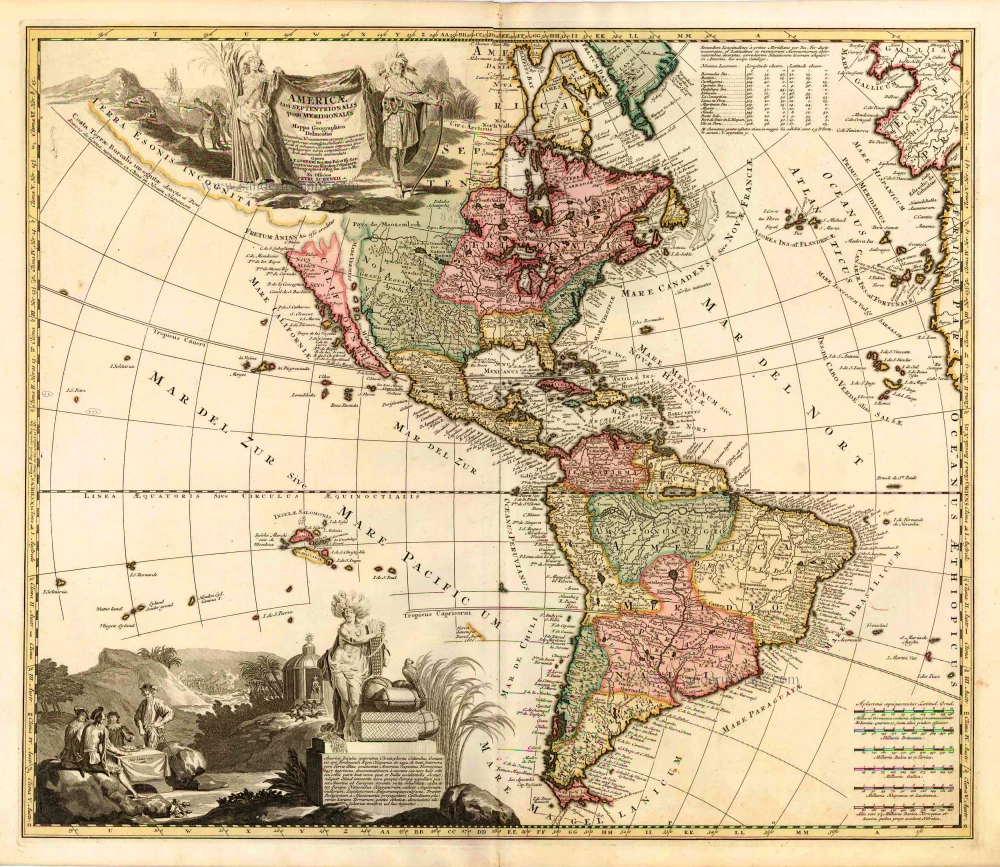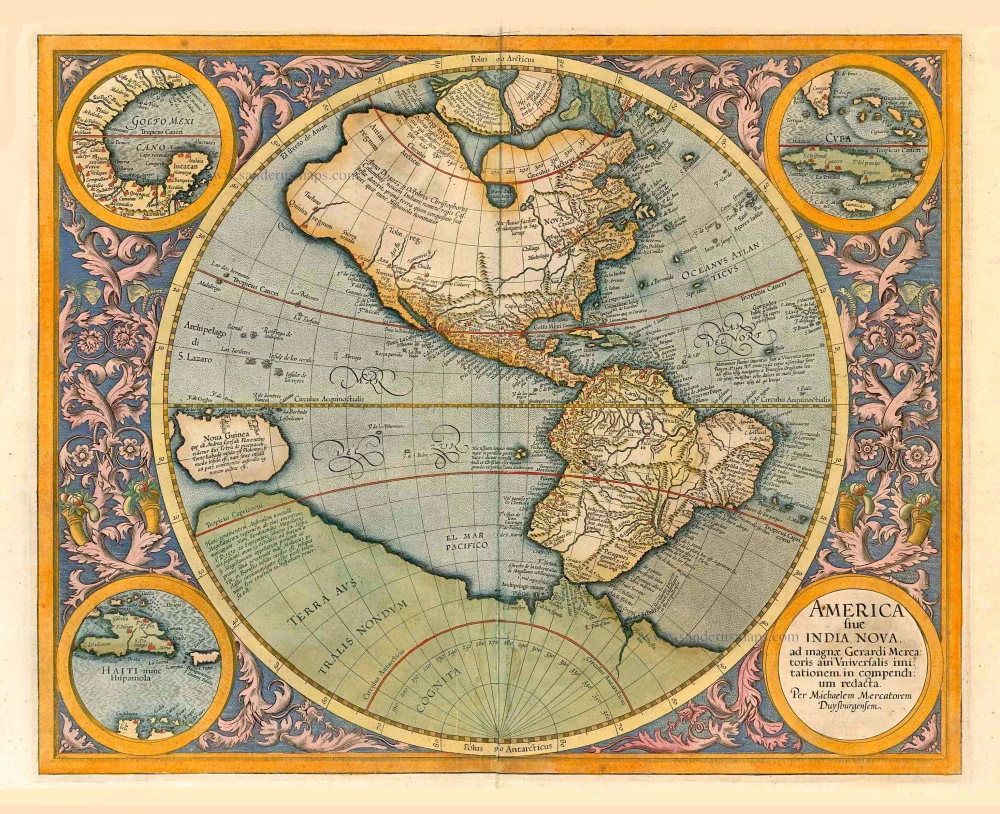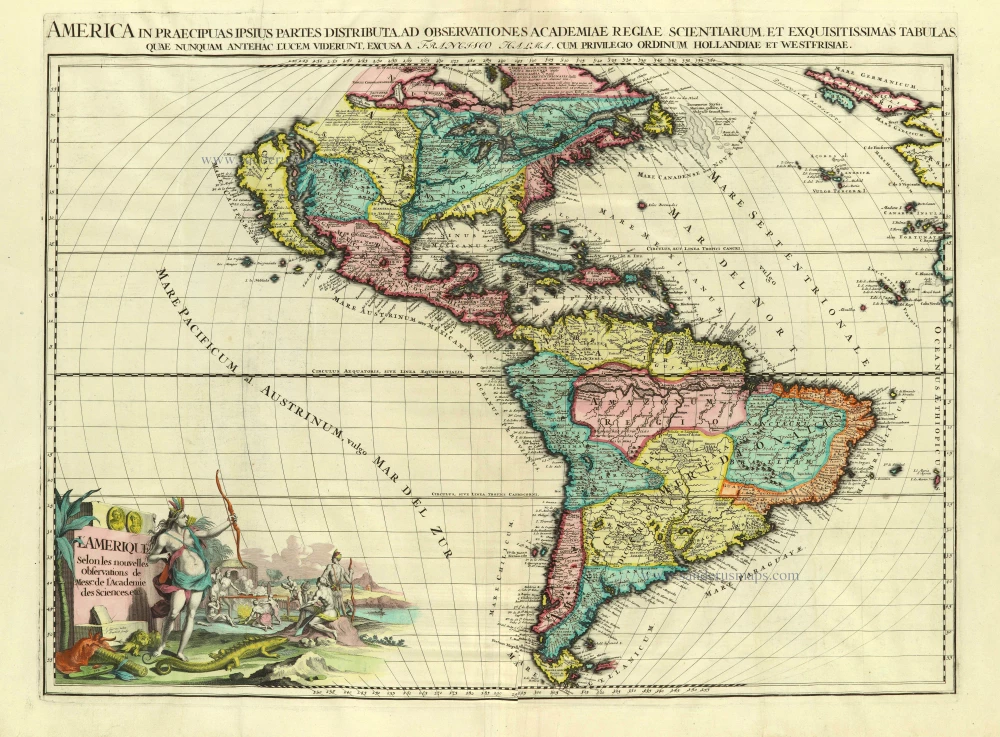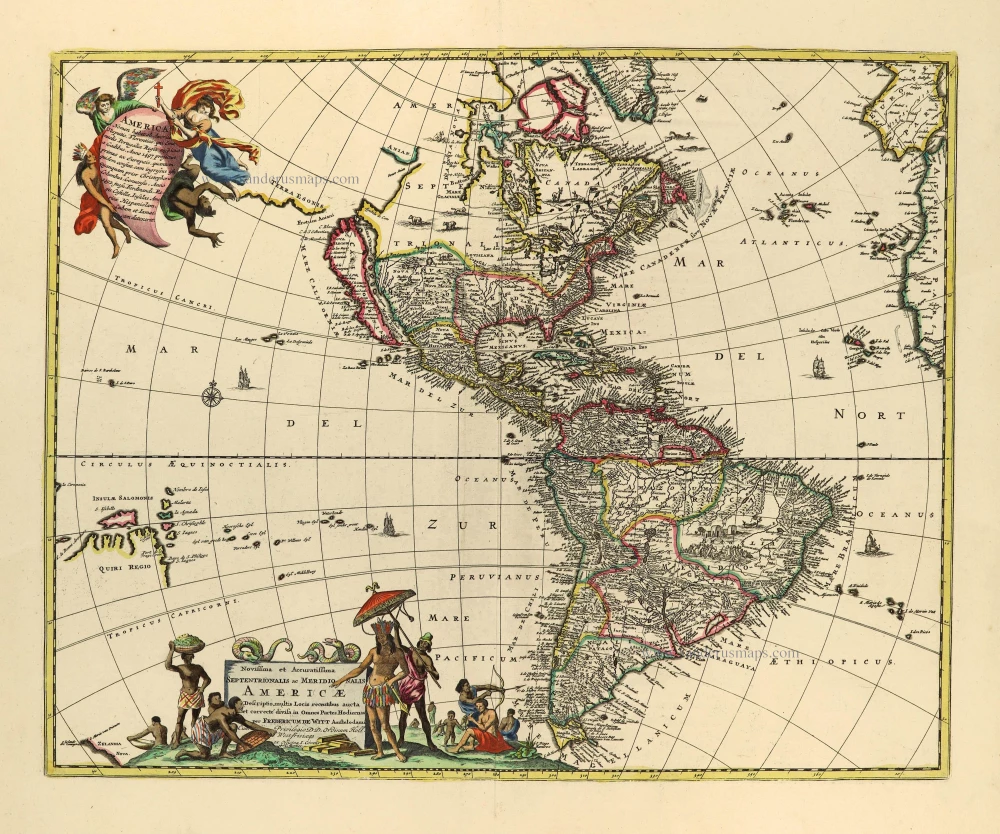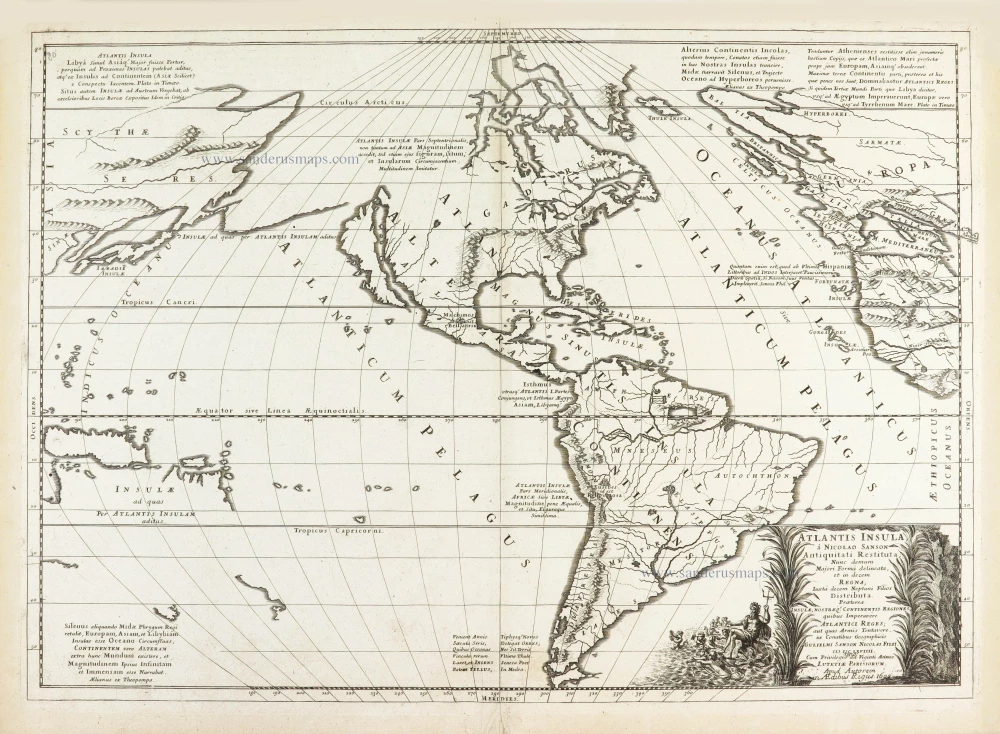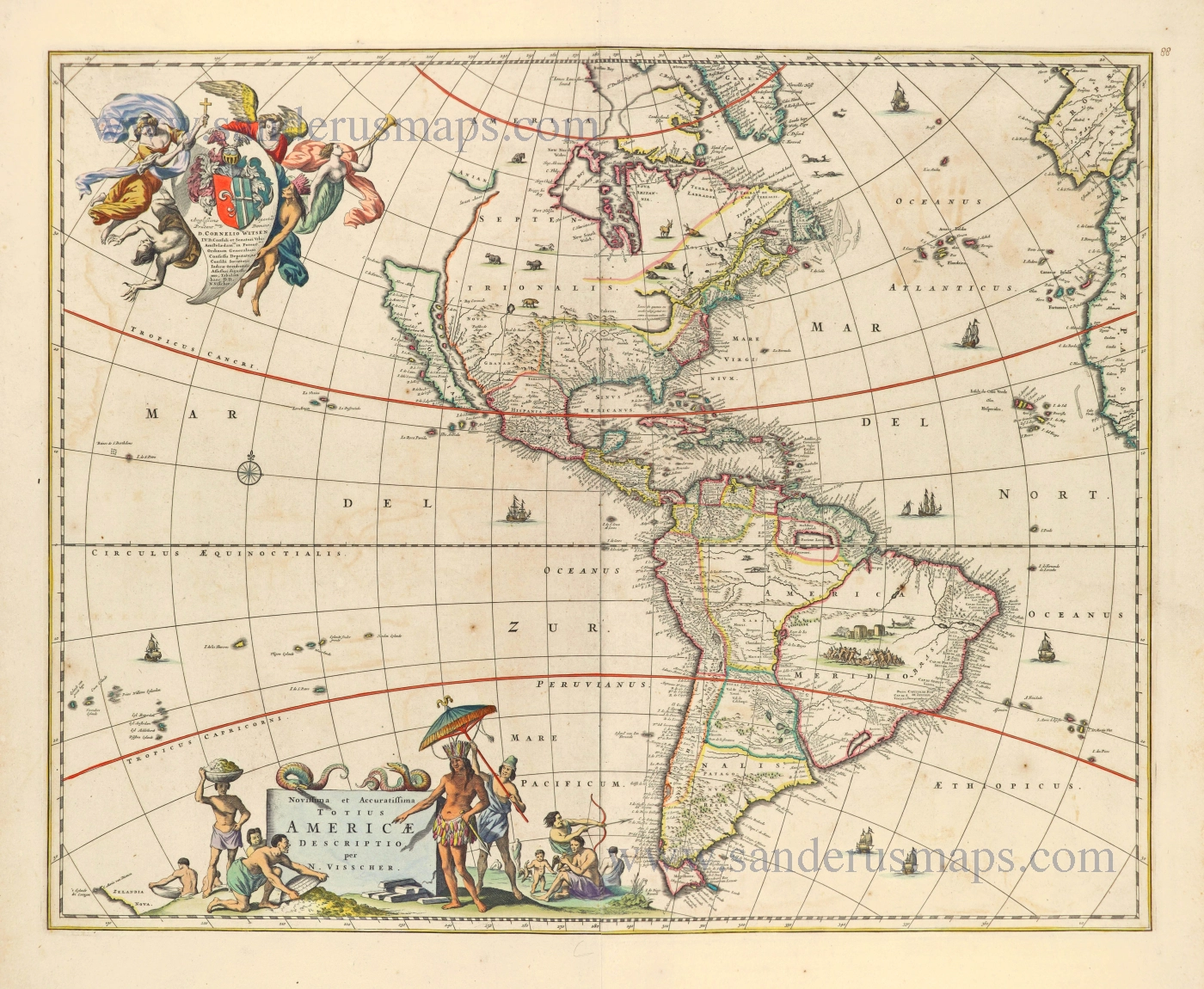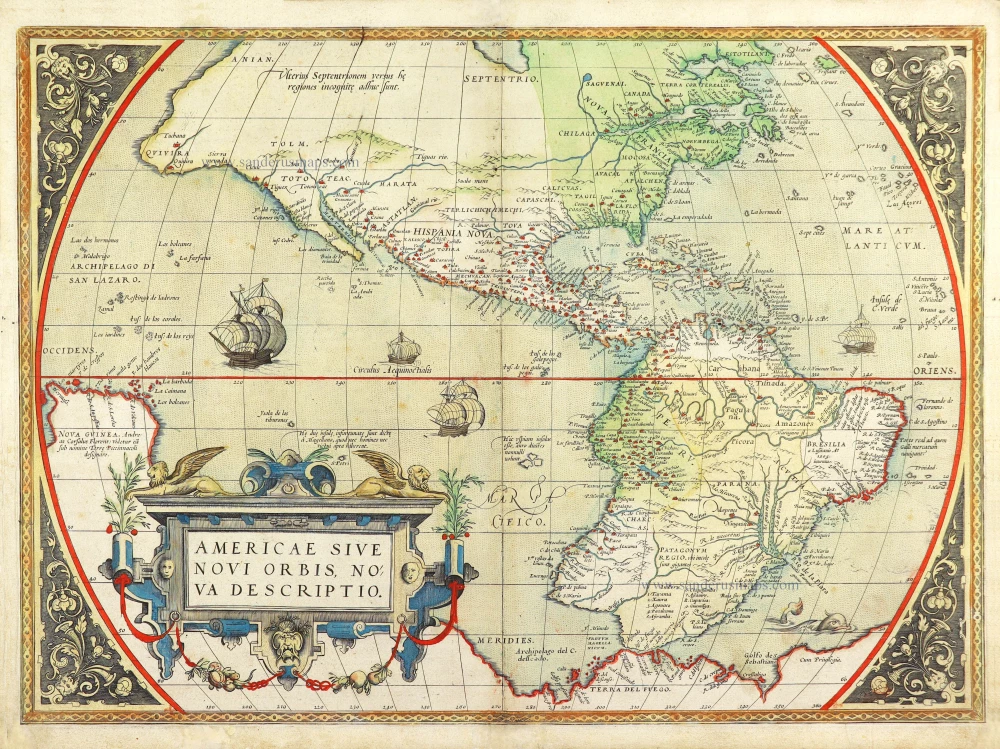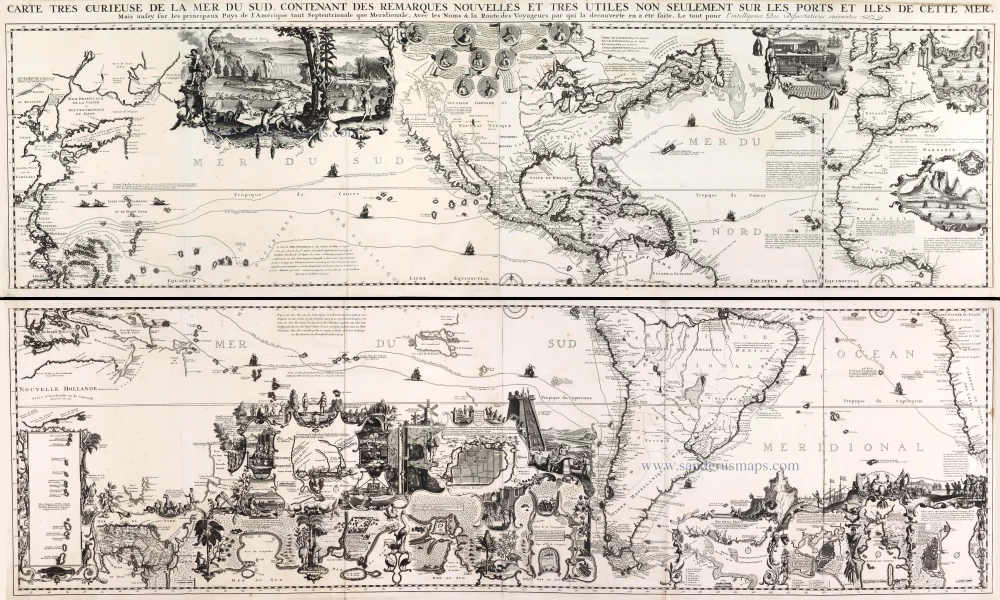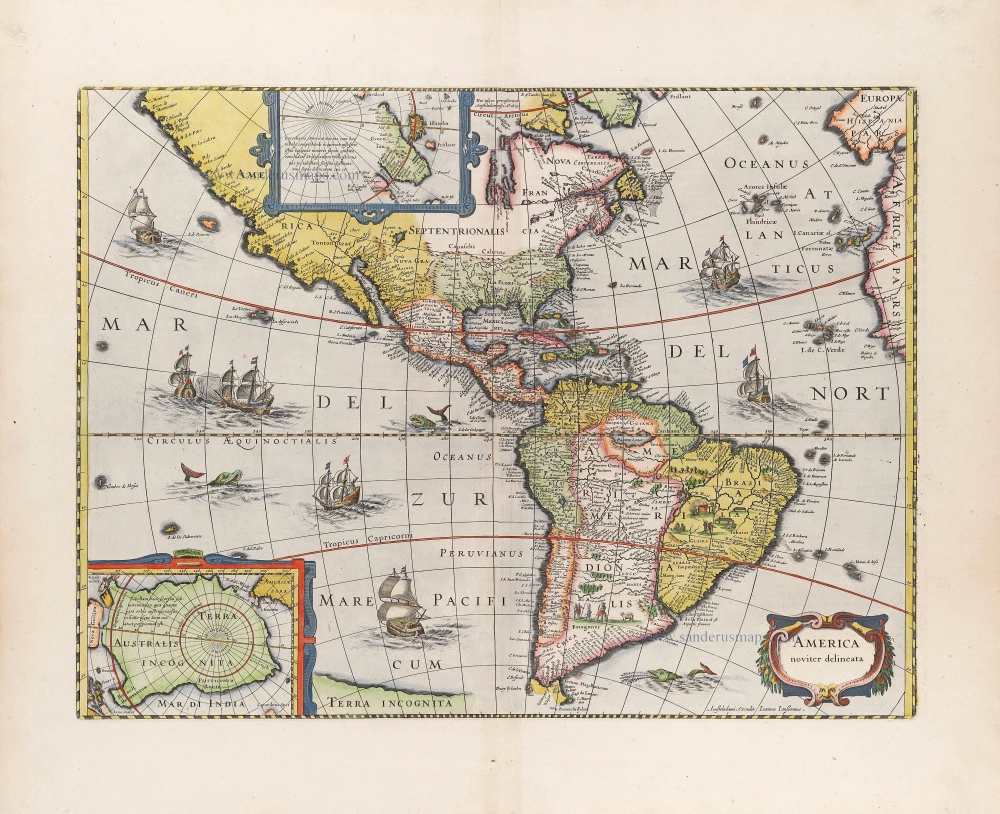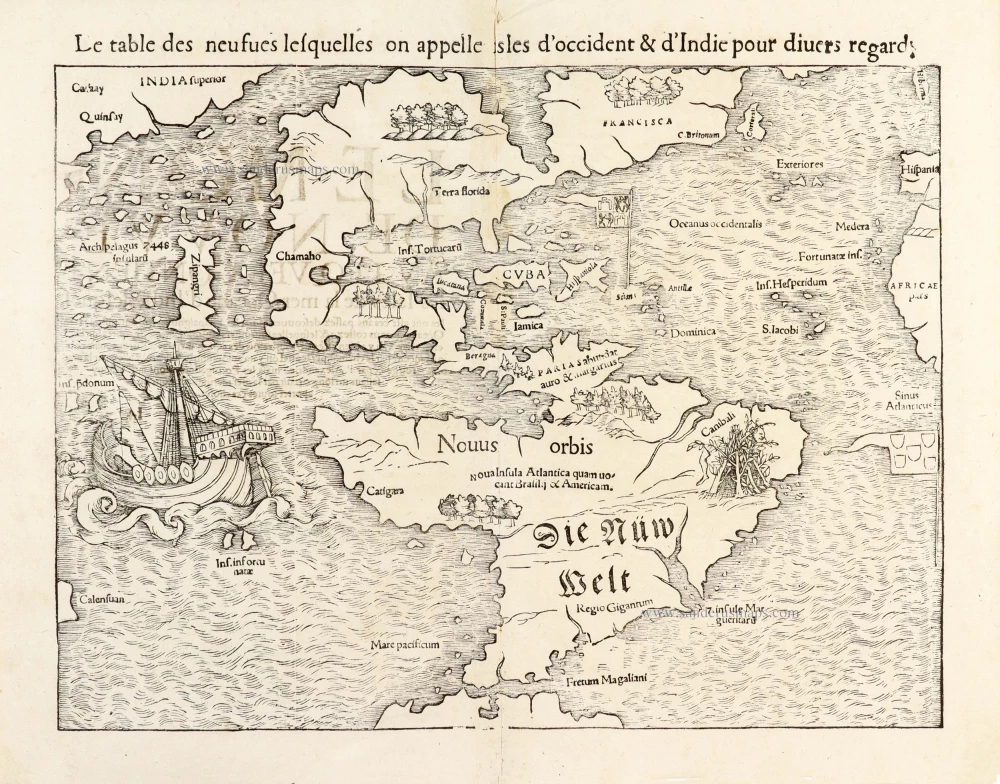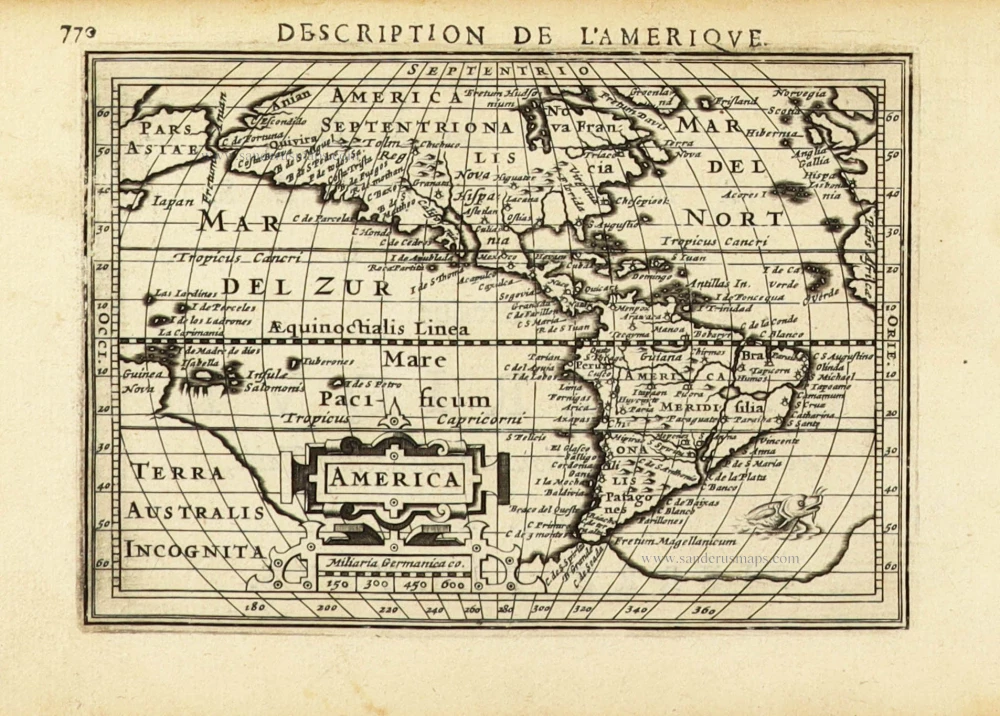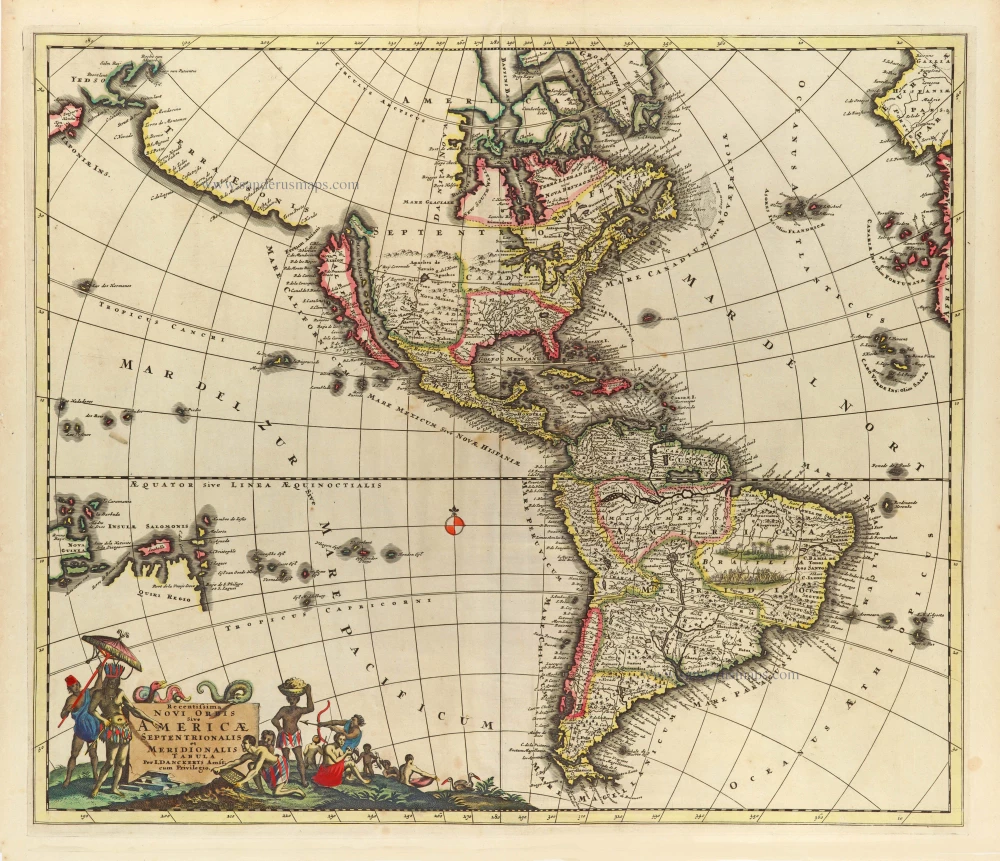America by Jodocus Hondius. 1613
"Jodocus Hondius engraved this map for his first edition of Gerard Mercator's atlas. It was intended to be a grand comprehensive work, with the first part appearing in 1585. However, by Mercator's death in 1594, only two parts had been published. Continued by his family, it was still incomplete for the 1602 edition, lacking, most notably, a section on the Iberian peninsula. During this time, it was also competing with the remarkably successful atlas of Abraham Ortelius, which averaged almost one edition per year. By 1604 Jodocus Hondius was flourishing and acquired all of the plates from Mercator's descendants. He immediately set about engraving many new maps to augment and complete the work, amongst which was a set of the four continents. He also had the original text expanded by Petrus Montanus. In the following year, he brought out Mercator's Ptolemy, and in 1606 his first edition of the general atlas proved instantly popular, selling out within a year.
Until 1630, this attractive map was issued alongside the AMERICA sive INDIA NOVA by Michael Mercator 1595. Since the Mercator always used the text describing America, this one is always lacking. Produced on a stereographic projection like more and more maps of the time, it is an amalgam of various sources. It incorporates a correct west coast of South America. It narrows the longitudinal width of New Spain at the Tropic of Cancer, making it just 10°, much closer to reality. However, like all cartography, it retains an enlarged North American continent. A Plancius-type depiction of Newfoundland occurs alongside a typical period representation of the east coast, with a more protruding Virginia than usual. Various scenes from the earlier volumes of de Bry's Grand Voyages adorn the whole. Particularly notable is the native Brazilian scene illustrating making a local beverage, derived from Hans Staden's voyage as recorded by de Bry. There are various ships, kayaks and Indian canoes, along with a pair of birds perched on the inset." (Burden)
The Hondius Family
Jodocus Hondius the Elder (1563-1612)
Joost d’Hondt was born at Wakken (Flanders) in 1563. Two years later, his family settled in Ghent, where young Joost displayed an excellent gift for drawing and calligraphy. Through study and lessons, he developed his talents and became an engraver with a good reputation.
Due to the circumstances of the war, he moved to London in 1584, where he settled down as an engraver, instrument-maker, and map-maker. In 1587, he married Coletta van den Keere, sister of the well-known engraver Pieter van den Keere (Petrus Kaerius); some years earlier, his sister, Jacomina, had married Pieter van den Berghe (Petrus Montanus). Joost, who had Latinized his name to Jodocus Hondius, closely co-operated with his two brothers-in-law.
The political situation in the Northern Netherlands in 1593 was such that Jodocus seemed justified in establishing himself in Amsterdam, where many Antwerp printers, publishers, and engravers had gone. In this new centre of cartography, Jodocus Hondius set up his business “In de Wackere Hondt” (in the vigilant dog), this name being an allusion to his birthplace and name. He engraved many maps and published atlases and many other works, such as his continuation of Gerard Mercator’s Atlas.
He suddenly passed away in February 1612. The publishing firm of Jodocus Hondius was continued by his widow, later on, by his two sons, Jodocus Jr. and Henricus, and by his son-in-law, J. Janssonius.
Jodocus Hondius II (1594-1629) & Henricus Hondius (1597-1651)
After the father’s death, the widow and her seven children continued publishing the atlases under the name of Jodocus Hondius till 1620. The firm was reinforced by the very welcome help of Joannes Janssonius (1588-1664), who married 24-year-old Elisabeth Hondius in 1612. After 1619, Mercator’s Atlas was published under the name of Henricus Hondius.
One of the most dramatic events in the early history of commercial cartography in Amsterdam was the sale of Jodocus Hondius Jr.’s copper plates to Willem Jansz. Blaeu in 1629, the year of his death. At least 34 plates, from which Jodocus II had printed single-sheet maps for his benefit, passed into the hands of his great competitor. Immediately after that, his brother, Henricus, and Joannes Janssonius ordered the engraving of identical plates.
Henricus devoted all his energy to publishing the Atlas for an extended period. He saw its growth up to and including the fourth part in 1646; after that, his name no longer figures on the title pages. After 1638, the title of the Atlas was changed to Atlas Novus; Joannes Janssonius mainly carried it on.
The competition with the Blaeu's dates from 1630. In 1630, Willem Janszoon (=Blaeu) first attacked with his Atlantis Appendix. In 1635, Blaeu completed his Theatrum Orbis Terrarum in two volumes with French, Latin, Dutch, and German texts, prompting Henricus Hondius to speed up the enlargement of his Atlas.
America.
Item Number: 28530 Authenticity Guarantee
Category: Antique maps > America > The Americas
Old, antique map of America, by Jodocus Hondius.
With an inset showing a scene of Indians preparing the fermented brew.
Title: America.
Jodocus Hondius excudit Amsterodami.
Date of the first edition: 1606.
Date of this map: 1613.
Copper engraving, printed on paper.
Map size: 375 x 505mm (14.76 x 19.88 inches).
Sheet size: 440 x 540mm (17.32 x 21.26 inches).
Verso: Latin text.
Condition: Original coloured, a few small verdigris cracks skillfully repaired.
Condition Rating: A
References: Van der Krogt 1, 9000:1B; Burden, #150; Wagner, #245; Portinaro & Knirsch, LXXIII.
From: Gerardi Mercatoris - Atlas sive Cosmographicae Meditationes de Fabrica Mundi et Fabricati Figura. Editio Quarta. Amsterdam, J. Hondius, 1613. (Van der Krogt 1:104)
"Jodocus Hondius engraved this map for his first edition of Gerard Mercator's atlas. It was intended to be a grand comprehensive work, with the first part appearing in 1585. However, by Mercator's death in 1594, only two parts had been published. Continued by his family, it was still incomplete for the 1602 edition, lacking, most notably, a section on the Iberian peninsula. During this time, it was also competing with the remarkably successful atlas of Abraham Ortelius, which averaged almost one edition per year. By 1604 Jodocus Hondius was flourishing and acquired all of the plates from Mercator's descendants. He immediately set about engraving many new maps to augment and complete the work, amongst which was a set of the four continents. He also had the original text expanded by Petrus Montanus. In the following year, he brought out Mercator's Ptolemy, and in 1606 his first edition of the general atlas proved instantly popular, selling out within a year.
Until 1630, this attractive map was issued alongside the AMERICA sive INDIA NOVA by Michael Mercator 1595. Since the Mercator always used the text describing America, this one is always lacking. Produced on a stereographic projection like more and more maps of the time, it is an amalgam of various sources. It incorporates a correct west coast of South America. It narrows the longitudinal width of New Spain at the Tropic of Cancer, making it just 10°, much closer to reality. However, like all cartography, it retains an enlarged North American continent. A Plancius-type depiction of Newfoundland occurs alongside a typical period representation of the east coast, with a more protruding Virginia than usual. Various scenes from the earlier volumes of de Bry's Grand Voyages adorn the whole. Particularly notable is the native Brazilian scene illustrating making a local beverage, derived from Hans Staden's voyage as recorded by de Bry. There are various ships, kayaks and Indian canoes, along with a pair of birds perched on the inset." (Burden)
The Hondius Family
Jodocus Hondius the Elder (1563-1612)
Joost d’Hondt was born at Wakken (Flanders) in 1563. Two years later, his family settled in Ghent, where young Joost displayed an excellent gift for drawing and calligraphy. Through study and lessons, he developed his talents and became an engraver with a good reputation.
Due to the circumstances of the war, he moved to London in 1584, where he settled down as an engraver, instrument-maker, and map-maker. In 1587, he married Coletta van den Keere, sister of the well-known engraver Pieter van den Keere (Petrus Kaerius); some years earlier, his sister, Jacomina, had married Pieter van den Berghe (Petrus Montanus). Joost, who had Latinized his name to Jodocus Hondius, closely co-operated with his two brothers-in-law.
The political situation in the Northern Netherlands in 1593 was such that Jodocus seemed justified in establishing himself in Amsterdam, where many Antwerp printers, publishers, and engravers had gone. In this new centre of cartography, Jodocus Hondius set up his business “In de Wackere Hondt” (in the vigilant dog), this name being an allusion to his birthplace and name. He engraved many maps and published atlases and many other works, such as his continuation of Gerard Mercator’s Atlas.
He suddenly passed away in February 1612. The publishing firm of Jodocus Hondius was continued by his widow, later on, by his two sons, Jodocus Jr. and Henricus, and by his son-in-law, J. Janssonius.
Jodocus Hondius II (1594-1629) & Henricus Hondius (1597-1651)
After the father’s death, the widow and her seven children continued publishing the atlases under the name of Jodocus Hondius till 1620. The firm was reinforced by the very welcome help of Joannes Janssonius (1588-1664), who married 24-year-old Elisabeth Hondius in 1612. After 1619, Mercator’s Atlas was published under the name of Henricus Hondius.
One of the most dramatic events in the early history of commercial cartography in Amsterdam was the sale of Jodocus Hondius Jr.’s copper plates to Willem Jansz. Blaeu in 1629, the year of his death. At least 34 plates, from which Jodocus II had printed single-sheet maps for his benefit, passed into the hands of his great competitor. Immediately after that, his brother, Henricus, and Joannes Janssonius ordered the engraving of identical plates.
Henricus devoted all his energy to publishing the Atlas for an extended period. He saw its growth up to and including the fourth part in 1646; after that, his name no longer figures on the title pages. After 1638, the title of the Atlas was changed to Atlas Novus; Joannes Janssonius mainly carried it on.
The competition with the Blaeu's dates from 1630. In 1630, Willem Janszoon (=Blaeu) first attacked with his Atlantis Appendix. In 1635, Blaeu completed his Theatrum Orbis Terrarum in two volumes with French, Latin, Dutch, and German texts, prompting Henricus Hondius to speed up the enlargement of his Atlas.

